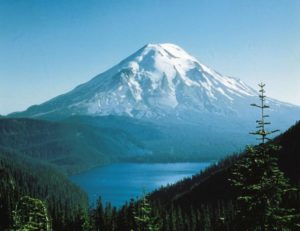
Mount St. Helens before the eruption. More than 1,300 feet of the top of this “Fuji of America” disappeared in a matter of seconds on 18 May, 1980.
Photo from USGS.
And I would have liked to have known you
But I was just a kid
Your candle burned out long before
Your legend ever did
-Elton John, Candle In The Wind
THE FLEETING GLORY OF YOUTH
It is surprisingly difficult to find good photographs of pre-1980 Mount St Helens. There should have been so many more. The volcano was – as nearly all children are – unimprovable. Symmetrical, innocent, fresh, elegant, sometimes moody but always approachable, and beautiful in every season, St Helens was small enough to hug but big enough to command the same type of respect one might accord the young daughter of a Governor. It was perfectly fine to marvel at her beauty or even ask her for a dance, but it was still a good idea to remember your place.
On Sunday May 18th, at 8:32 in the morning, that all changed. In a few clicks of the shutter St Helens became a deadly-angry, furrowed old crone. Not that this inevitable metamorphosis came as a surprise – such arresting beauty is always a fleeting thing. But it is still difficult to understand why we don’t remember her for what she once was. We do it for Marilyn Monroe.
Then again, St. Helens is more relevant today than she ever was in the fleeting glory of her youth. The lessons she continues to teach have yielded new understandings in ecology and geomorphology, and profoundly contributed to the science of volcano prediction. These lessons played no small part in the near pin-point accuracy the USGS demonstrated in the days leading up to the 1997 Montserrat and 1991 Mount Pinatubo eruptions, saving countless lives in the bargain. And being a child of the Cascades Volcanic Arc, St. Helens is just the youngest of many siblings that dominate the skyline from British Columbia to northern California, each possessing similar potential to reawaken on short notice. This WEDNESDAY, (August 17th) at the Teton County Library Auditorium at 6:00 pm our own Dr. Robert Tilling, Volcanologist Emeritus, Volcano Science Center, USGS, will tell us all about Mount St. Helens, what she is teaching us now, and how the Cascadia Subduction Zone gave rise to her extended family of volcanos and rare but incredibly destructive earthquakes and related tsunamis. Note that the primary election this Tuesday has pushed this important lecture back a day. See you Wednesday!
